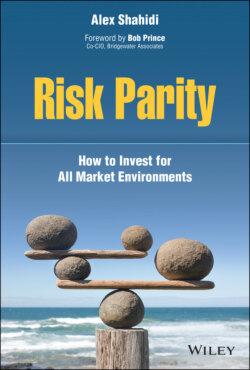Читать книгу Risk Parity - Alex Shahidi - Страница 25
CHAPTER TWO Two Steps to Build a Well‐Balanced Portfolio
ОглавлениеWhile I was on my journey to determine the optimal portfolio, one that could stand the test of time, Bridgewater introduced me to a conceptual discovery that provided a philosophical breakthrough. The traditional thought process of constructing a diversified portfolio joins two core concepts into one: risk and return. Equities have high risk and high return, while traditional intermediate‐term bonds have low risk and low return. When viewed through a conventional lens, these two options force the investor to have to choose between risk and return by deciding how much to invest in high‐returning stocks versus low‐returning but safer bonds. Accepting greater risk results in higher returns over time, and accepting less risk results in lower returns. There is a well‐established and, in many ways, commonsense compromise that you can't expect higher returns without taking more risk and you can't expect lower risk if you seek higher returns.
A simple shift in investment approach can completely change the logical path that can be followed to arrive at a more ideal portfolio solution. From a high level, there are two fundamental steps:
1 Which asset classes should we own to reduce risk?
2 How do we structure each asset class to get an equity‐like return?
We can consider risk and return separately. First, we should explore how to build an allocation of highly diverse asset classes to manage risk (without concern for the returns of those asset classes). By removing the return constraint and focusing purely on risk mitigation, we can open up the universe of viable options to maximize diversification. After we have identified the appropriate assets in which to invest, then we can structure each to have an acceptable expected return.
The goal of this chapter is to introduce this new perspective by first providing an overview of the conceptual framework. I will attempt to keep the discussion high‐level in the remainder of this chapter to lay out the roadmap. The following chapters will dive into each component with greater detail.
